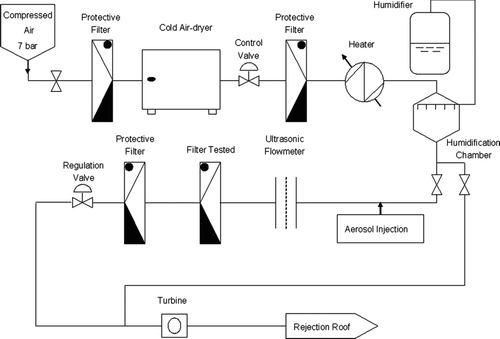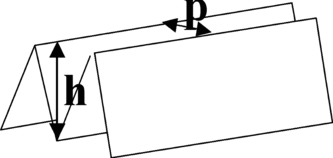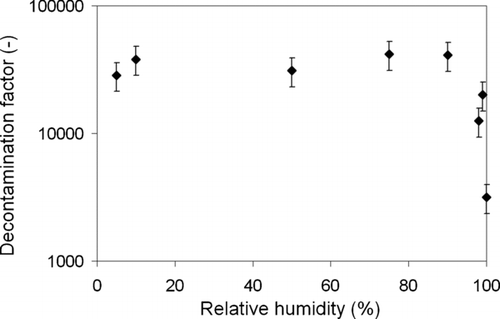Abstract
The influence of humidity on changes to the pressure drop of flat and pleated HEPA filters clogged by polydisperse hygroscopic and non-hygroscopic aerosols has been studied. For flat filters, the results confirm the observations reported by CitationGupta et al. (1993) that with a hygroscopic aerosol at humidity below the deliquescent point, or with a non-hygroscopic aerosol, the particulate specific cake resistance decreases as relative humidity increases. For pleated filters as for flat filters, the results reveal that during the formation of the particulate cake, the increase in relative humidity leads to a decrease in the specific cake resistance. When the reduction in filtration area, specific to pleated filters, becomes large, the presence of humidity accelerates the filling of pleats causing a greater pressure drop for a same aerosol mass loading. With a hygroscopic aerosol at a humidity above its deliquescent point, the change in pressure drop through flat or pleated filters is not linear but characteristic of liquid aerosol filtration. The influence of humidity on the efficiency of pleated filters, measured by a soda fluorescein aerosol, has also been studied. For clean filters, the efficiency decreases with increasing relative humidity above 90%. For filters clogged with solid aerosol, change in efficiency versus collected surface mass reaches a maximum whose value depends on the relative humidity; when the aerosol is liquid, the efficiency decreases throughout the clogging.
1. INTRODUCTION
Pleated High Efficiency Particulate Air (HEPA) filters are frequently used in ventilation systems and particularly in nuclear facilities for the containment of radioactivity. The pressure drop and the efficiency depend on many parameters such as particle diameter, fluid velocity, and so on. Moisture is also an important consideration in the design of an air cleaning system. Indeed, the humidity of the air may affect the performance of HEPA filters in terms of both pressure drop and efficiency. In nuclear reactors, large volumes of steam and moisture would be expected to arise in the highly unlikely event of a major loss-of-coolant accident or a heat exchanger failure. When fire-protection sprinklers are provided in operating areas, their activation could result in moisture being drawn into the filters.
Although important, the influence of moisture on the clogging of fibrous filters has been little studied. Because of this, there is no analytical study available in the literature for predicting the influence of humidity on the performance of pleated HEPA filters. Indeed, the majority of studies use flat filters. Unfortunately, these two geometries—flat and pleated—do not exhibit similar pressure drop change characteristics (CitationDel Fabbro et al. 2001).
To redress this lack of knowledge, we have studied the influence of the presence of humidity on changes in pressure drop and efficiency of pleated HEPA filters during clogging by a non-hygroscopic aluminium oxide aerosol and by a hygroscopic sodium chloride aerosol. The clogging of flat filters has also been studied, to investigate the influence of filter geometry on changes in pressure drop.
2. LITERATURE REVIEW
The evolution of the pressure drop of a pleated HEPA filter when challenged with a solid aerosol exhibits three stages (CitationDel Fabbro et al. 2001):
-
in-depth filtration corresponding, as for flat filters, to a deposit of particles inside the medium. During this stage, the pressure drop across the filter changes very little;
-
surface filtration (or cake filtration) corresponding to the development of a particulate cake on the surface of the medium. This stage is also common to flat filters, but for pleated filters, the area of filtration surface is reduced as the particulate cake builds up. At the beginning of clogging, this reduction of the filtration surface is not sufficiently large to modify the linear evolution of the pressure drop;
-
reduction of the filtration surface causing an exponential increase in the pressure drop of the filter. It is difficult to predict the value of the collected mass at which reduction of surface area starts to be important.
For flat filters, during the cake filtration stage, CitationNovick (1992) considers that the pressure drop of the filter (ΔP) results from two contributions: the pressure drop of the clean filter (ΔP 0), which can be calculated from Darcy's law, and the pressure drop through the particulate cake (ΔPc ) which comes from the drag force acting on each individual particle forming the cake and a factor which takes into account the proximity of the particles to each other.
Therefore, neglecting the fast in-depth filtration stage, according to CitationNovick (1992) the pressure drop of a HEPA filter during the cake filtration stage for a solid aerosol in laminar flow regime is expressed in the form:
For pleated filters, changes in pressure drop during clogging are more complicated due to the reduction of the filtration surface area and the way in which the particles build up along the pleats. Del Fabbro et al. (2001) have established a clogging model for pleated HEPA filters by micron-sized particles based on a dimensionless approach. This model is, however, difficult to use because it requires the changes which occur in the air flow resistance of the filtering medium throughout clogging to be input as data. CitationRebai et al. (2009) have proposed a numerical model to simulate the clogging of a pleated filter; this model is obtained by combining a semi-analytical model of the flow in a pleated filter and an empirical model of clogging of a flat filter medium.
When considering the influence of humidity on the pressure drop of a clean water-repellent flat HEPA filter, CitationGupta et al. (1993) noted no change when the filter was subjected to relative humidities between 1 and 100%. With pleated HEPA filters, CitationNormann (1987) noted, for filters conditioned for six hours at relative humidities between 50% and 100% and an ambient temperature close to 20°C, that the pressure drop of filters increases for relative humidities greater than 90%. The results of CitationGupta et al. (1993) and CitationNormann (1987) seem contradictory, but this may be explained by their different experimental conditions, for example the exposure time of the medium to the flow of humid air or condensation of the vapor into the medium.
The work of CitationGupta et al. (1993), performed with flat HEPA filters, highlighted the importance of the hygroscopic nature of aerosols on the evolution of the pressure drop of a filter during its clogging. For a non-hygroscopic aerosol or a hygroscopic aerosol at relative humidity below its deliquescent point, the increase in filter pressure drop is much lower than when the humidity is high; for a hygroscopic aerosol at relative humidity above its deliquescent point, the pressure drop of the filter increases exponentially after a certain mass of droplets has collected. The same observations have been reported by CitationMiguel (2003) with large-diameter polyester fiber filters clogged with hygroscopic and non-hygroscopic aerosols.
CitationSmith et al. (1993) studied the mechanical resistance of HEPA filters with deep pleats, pre-clogged under high or low humidity by a sodium chloride aerosol. The results showed that a filter clogged under low humidity had reduced mechanical resistance, whereas if the clogging occurred under high humidity, the mechanical resistance could be compared with a clean filter.
CitationGregory et al. (1982) studied the influence of humidity on the air flow resistance of HEPA filters with deep pleats when clogged by a stearic acid submicron aerosol. It seems that the filter air flow resistance, for a given aerosol mass loading, is greater when the filter is operating in dry air. In other words, the air flow resistance of the filter is lower when clogging occurs under humid conditions. Once saturation is reached, an additional injection of water causes a further decrease in the filter's air flow resistance for the same aerosol mass loading.
To conclude, this literature review has revealed a lack of data on the influence of humidity on pleated filters. The results obtained with flat filters constitute a valuable database, but a study of pleated filters remains indispensable. The few studies of deep-pleated HEPA filters that are available provide little analytical data on the influence of humidity during their clogging. Indeed, the reports are generally imprecise in terms of the operating conditions or parameters studied.
3. EQUIPMENT AND METHOD
3.1. Experimental Test Bench
The test bench used during this study, installed at the Institute for Radiological Protection and Nuclear Safety in Saclay (France), has been designed to analytically characterize filtration under humid conditions by pleated and flat HEPA filters. It enables the filtered air to be controlled and regulated in terms of flow rate (30 to 200 m3 · h−1 at 20°C), temperature (8°C to 100°C) and humidity (from a few % to saturation depending on the temperature). Heat trace cables over the entire test bench, insulated in advance, prevent any condensation on the walls. The humidity is measured before and after the filter using capacitive hygrometers and a condensation hygrometer.
is a schematic diagram of the experimental test bench. First, previously filtered compressed air enters a cold air-dryer. On leaving, the air is at a temperature of 8°C and a relative humidity of 12% and a regulator reduces the pressure from 7 bar to 1.5 bar. The compressed air then passes through a control valve which is responsible for maintaining atmospheric pressure at the entrance to the ventilation system. After circulating through a filter, the air passes through a resistance heater which can raise the temperature to 100°C. The air is humidified by a humidifier inside the humidification chamber. It then either circulates through the bypass to the roof-mounted discharge point or through the equipment to test. A second straight length allows the introduction of aerosols at uniform concentrations and an ultrasound flow meter controls the filtration flow rate in real time. The air passes through the filter being tested, through a protective filter and then through a second regulation valve which compensates the increase in the pressure drop from the filter clogging by opening gradually; thus, the regulation valve ensures a constant filtration flow rate in the filter during the test. Lastly, the air passes through a turbine and is expelled on the roof.
The range of filtration velocities investigated, corresponding to a laminar flow regime, was from 4.0 to 7.0 cm · s−1 for the flat filters and around 2.6 cm · s−1 for the pleated filters. Relative humidity was investigated from a few percent to near saturation. The temperature was fixed at 25°C ± 2°C. The pressure drop through the filter and the flow rate of the generated aerosol were measured continuously during the clogging. Changes in aerosol mass loading were calculated from experimental changes in the flow rate of the generated aerosol and from the weight of the filters (the filters were weighed before and after clogging).
The efficiency of pleated filters was evaluated for the whole medium at a filtration velocity of 2.6 cm · s−1. French normalized soda fluorescein particles (NFX 44-011), whose size distribution (mass median aerodynamic diameter = 0.18 μm, standard geometric deviation = 1.6) includes the most penetrating particle size, are injected upstream of the filter being tested. The normalized particles are generated by spraying of a liquid solution and drying the droplets. The soda fluorescein particle concentration is then determined by fluorimetry from samples performed upstream and downstream of the filter being tested. The efficiency of the filter is expressed by the Decontamination Factor (DF), corresponding to the ratio of the upstream concentration of soda fluorescein particles to the downstream concentration of particles. DF is usual in nuclear industry where efficiency of filters is very high (more than 99.9%).
3.2. Filters Tested
Two types of filter, made from the same medium, were tested: flat filters with 0.08 m2 filtering area and pleated filters of 0.42 m2. The main characteristics of the filter medium are presented in . The thickness of the filter medium was determined from scanning electronic microscopy observations. The weight was estimated by weighing of samples with known surface. The packing density was deduced from the thickness and weight values. The diameter of the glass fibers follows a log-normal size distribution (deduced from scanning electronic microscopy observations). The pleating characteristics of pleated filters () are those usually found in the French nuclear industry: height of pleat h = 27.5 mm and distance between adjacent pleats p = 2.1 mm; this kind of pleated filters are called mini-pleated filters (in contrast to deep pleat filters h > 200 mm). The test filters are not electrically charged.
TABLE 1 Main characteristics of the filtering medium
3.3. Aerosols Used to Clog the Filters
Two types of hygroscopic aerosol with differing sizes were used to clog the filters: a micron-sized, non-hygroscopic, aluminium oxide aerosol and a submicron, hygroscopic, sodium chloride aerosol.
The aluminium oxide aerosol was produced by dispersing powder using a Palas BEG-1000 generator. Changes in generated-aerosol flow rate were recorded during the test. The size distribution of the aerosol was characterized for different relative humidity values using an TSI Aerodynamic Particle Sizer (APS), which provided an aerodynamic diameter. The results, reported in , show a slight shrinking of particles at 90% relative humidity. The Mass Median Aerodynamic Diameter (MMAD) decreases from 4.2 μm at 10% RH to 3.9 μm at 90%. CitationEbert et al. (2002) and CitationMikhailov et al. (2001) also noted shrinking of soot particle size in the presence of high humidity and CitationWeingartner et al. (1995) made the same observation for carbon particles. Two explanations can be postulated: either some of the water vapor is adsorbed at the particle surface and thus modifies their shape factor, or the humidity in the air leads to the formation of agglomerates which sediment out in the test bench, thereby altering the size distribution of the aerosol.
TABLE 2 Size distribution of the aluminium oxide aerosol at different relative humidities (RH)
The sodium chloride aerosol was produced by aqueous spraying of a 200 g · l−1 NaCl solution. The size distribution of the sodium chloride aerosol was characterized for different air humidity values by a Grimm Scanning Mobility Particle Sizer (SMPS), which gives an electric mobility diameter. reports the results with the Equivalent Volume Median Diameter (EVMD) which is calculated from the size distribution of the electric mobility diameter and the relation (Equation2) with a shape factor of 1.08 (in accordance with the cubic shape of the NaCl particles).
TABLE 3 Size distribution of the sodium chloride aerosol at various humidities
The results show that the EVMD decreases from 0.40 μm to 0.21 μm when RH increases from 5% to 70%. The same behavior has already been reported with NaCl particles in publications, by Krämer et al. (2000) and CitationBiskos et al. (2006) in particular. According to the authors, the primary NaCl particles leaving the generator, bond together and are rearranged in the presence of humidity. Beyond 75% RH, deliquescence is reached and the aerosol is liquid.
4. RESULTS AND DISCUSSION
4.1. Influence of Humidity on the Initial Performance of Clean Pleated HEPA Filters
The influence of humidity has been studied on the initial performance of pleated HEPA filters in terms of pressure drop and efficiency.
shows the evolution of the ratio ![]() for a clean pleated filter when exposed to a humid flow for 1 h between 18% and 100% relative humidity; ΔP
0 corresponds to the pressure drop of the filter at the beginning of the test. The results reveal that ratio
for a clean pleated filter when exposed to a humid flow for 1 h between 18% and 100% relative humidity; ΔP
0 corresponds to the pressure drop of the filter at the beginning of the test. The results reveal that ratio ![]() exhibits no significant change with time in the humidity range tested. So, the RH doesn't affect the pressure drop of the clean filter, which suggests a water repellent treatment of the fibers implemented in the industrial filter medium tested in this study.
exhibits no significant change with time in the humidity range tested. So, the RH doesn't affect the pressure drop of the clean filter, which suggests a water repellent treatment of the fibers implemented in the industrial filter medium tested in this study.
The influence of humidity on the initial efficiency of pleated filters has been studied. The measurements were performed at 2.6 cm · s−1, between 5 and 100% relative humidity and with soda fluorescein particles. The results depicted in , show that the decontamination factor (corresponding to the ratio of the upstream concentration of soda fluorescein particles to the downstream concentration of particles) of clean pleated filters is not significantly affected by the presence of relative humidity at between 10 and 90%. Beyond 90% RH, the decontamination factor decreases with increasing RH. The decontamination factor of the clean filters tested exceeds a value of about 35,000 in humid air (RH < 90%) and drops to about 3000 for air close to saturation. This decrease in the decontamination factor above 90% RH is difficult to interpret quantitatively; however, it is likely to be related to the deliquescence of soda fluorescein particles becoming liquid and their interaction with the fibers of the filter medium. Thus, the decrease in the decontamination factor is linked to the deliquescent point of the airborne aerosol.
4.2. Influence of Humidity on Changes in Pressure Drop
4.2.1. Results for Flat Filters
The clogging of flat filters is expressed as the ratio of the pressure drop minus the initial pressure drop of the filter over the filtration velocity ![]() as a function of the collected surface mass. The filtration velocity is kept constant during the clogging and, according to various studies in the literature (CitationWalsh 1996; CitationPénicot et al. 1999), the increase in pressure drop is linear during cake filtration; thus, plotting Equation (Equation1), and using a collected surface mass value corresponding to cake filtration, the gradient of each straight line is proportional to the experimental specific cake resistance.
as a function of the collected surface mass. The filtration velocity is kept constant during the clogging and, according to various studies in the literature (CitationWalsh 1996; CitationPénicot et al. 1999), the increase in pressure drop is linear during cake filtration; thus, plotting Equation (Equation1), and using a collected surface mass value corresponding to cake filtration, the gradient of each straight line is proportional to the experimental specific cake resistance.
4.2.1.1. Aluminium Oxide Aerosol. The clogging curves using non-hygroscopic aluminium oxide aerosol (), indicate that the presence of humidity up to 95% RH does not have much influence on changes in pressure drop. For higher humidities, the increase in pressure drop is slower; in others words, the specific cake resistance for humidities close to 100% is less than that noted for lower humidities. These results corroborate those of CitationGupta et al. (1993) obtained with a 1 μm aluminium oxide aerosol, although their results reveal significant influence from humidity at values below 95% relative humidity.
FIG. 5 Evolution of the pressure drop of flat HEPA filters versus collected surface mass of aluminium oxide particles at different relative humidities and at filtration velocity of 4.0 cm·s−1.

The slight reduction in the diameter of the aerosol studied as RH rises cannot explain these results; indeed, such a reduction in diameter with RH should have tended to increase the specific cake resistance. CitationGupta et al. (1993) have suggested that the presence of humidity increases the particle-to-particle bonding forces; this assumption was validated by CitationFeng et al. (1998). They demonstrated that as the liquid content increases, porosity increases up to a maximum value. According to the authors, adding liquid onto particles leads to the formation of liquid bridges between them and generates a capillary force. This restricts the relative motion between particles when packing and hence gives a high porosity. According to CitationButt and Kappl (2009), liquid water, necessary for the existence of capillary forces, is formed by capillary condensation of the vapor into capillaries or fine pores of the particles even far above the dew point of the surrounding atmosphere.
4.2.1.2. Sodium Chloride Aerosol. Using the hygroscopic sodium chloride aerosol below the deliquescent point (75% RH), the clogging curves () reveal that the specific cake resistance decreases with increasing RH. In agreement with CitationGupta et al. (1993), the effect is more marked than for the non-hygroscopic aerosol.
FIG. 6 Evolution of the pressure drop of flat HEPA filters versus collected surface mass of sodium chloride particles at different relative humidities below the deliquescent point and at filtration velocity of 7.0 cm·s−1.
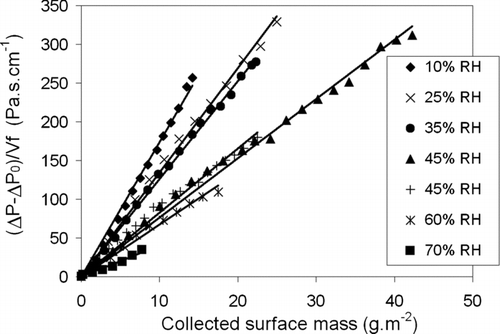
The clogging curves using hygroscopic sodium chloride aerosol above the deliquescent point () indicate changes in pressure drop that are characteristic of clogging by a liquid aerosol: the droplets start by filling the interstitial space between the fibers until formation of a liquid film on the surface of the medium causes an abrupt increase in the pressure drop (CitationContal et al. 2004). In agreement with CitationGupta et al. (1993), the liquid film appears at greater collected surface masses with increasing RH.
FIG. 7 Evolution of the pressure drop of flat HEPA filters versus collected surface mass of sodium chloride particles at different relative humidities above the deliquescent point and at filtration velocity of 7.0 cm · s−1.
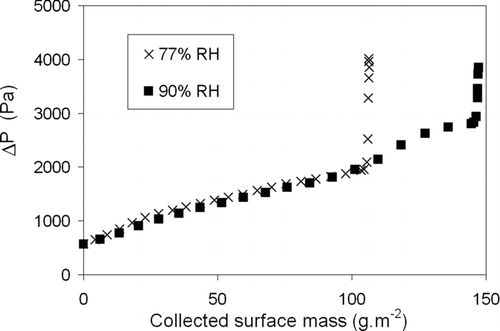
4.2.1.3. Influence of Particle Diameters. The results have been compared to those of CitationGupta et al. (1993). Figures and show the changes in experimental specific cake resistance as a function of relative humidity during clogging, for the aluminium oxide aerosol and the sodium chloride aerosol, respectively (the mass median aerodynamic diameters are specified).
FIG. 8 Changes in experimental specific cake resistance of aluminium oxide particles versus relative humidity and for various aerosol diameters.

FIG. 9 Changes in experimental specific cake resistance of sodium chloride particles versus relative humidity (below the deliquescent point) for various aerosol diameters.
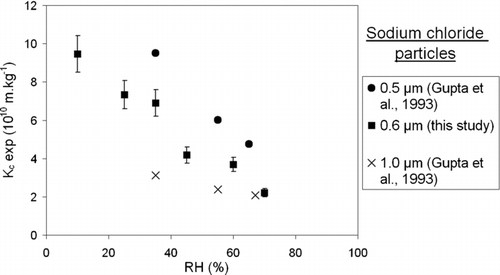
The figures indicate that the experimental results for both aerosols fit coherently with those of CitationGupta et al. (1993). Indeed, the results show that for a given relative humidity, the specific cake resistance decreases with increasing aerosol diameter. This decline is caused by the decrease in specific surface area of the particles as the diameter of the particles increases.
The results also show that the influence of the relative humidity of the air on the specific cake resistance of aluminium particles is more pronounced for a small diameter particle; indeed, for the 0.5 μm diameter aerosol, the specific cake resistance decreases for relative humidity above 80%, while for an aerosol of diameter 4.2 μm, the specific cake resistance decreases only for RH close to 100% and less significantly. For sodium chloride particles, although the range of diameters studied is more limited, the results also show that specific cake resistance decreases over the entire range of relative humidity (between 10 and 70%), whatever the diameter of the aerosol; as with aluminium oxide aerosol, the decrease seems to be more significant for the aerosol with the smallest diameter.
4.2.1.4. Microscopic Observation. To explain the influence of humidity on the deposition of particles, after clogging, observations of the surface of the flat filters were carried out using a scanning electron microscope (SEM). The photographs show views of the upstream face of clogged filters. It is important to note that relative humidity could not be controlled during filters storage and transport, so the following conclusions made from SEM photographs must be taken with caution. shows SEM photographs of filters clogged at 5, 45, and 60% RH by sodium chloride particles.
FIG. 10 SEM photographs of filters clogged by sodium chloride particles at different values of relative humidity: top left 5% (23 g·m−2), top right 45% (23 g · m−2), and bottom 60% (18 g·m−2).

The photographs show that the sodium chloride particles adhere to each other more closely when the relative humidity during clogging is high. Indeed, because of the submicron diameters of the particles, the deposits on the surface of the filters mainly form into dendrites (CitationThomas et al. 2001). However, for the filters clogged at 45 and 60% relative humidity, in addition to the dendritic network, many clusters of particles are also visible; some are framed on the photograph. The total surface area of several agglomerated particles is less than the sum of the surface areas of all their individual particles. This may explain why, for a given mass of collected particles, a particulate cake formed in the presence of humidity has a lower pressure drop than a cake that is built up in dry air.
Thus, since the presence of humidity leads to agglomeration of particles deposited on the filter, this explains why the effect of humidity is more marked with small diameter particles (for the same hygroscopicity of particle). Indeed, the deposit of micron-sized particles in dry air leads to the formation of agglomerates (CitationThomas et al. 2001), so the presence of humidity has no further influence on the deposit and on the pressure drop of the filter; for submicron particles, the deposit in dry air is dendritic and hence very sensitive to the presence of humidity (via adhesive forces).
4.2.2. Results on Pleated Filters
The results with pleated filters are expressed using the ratio of the pressure drop during clogging over the initial pressure drop ![]() as a function of the collected surface mass.
as a function of the collected surface mass.
4.2.2.1. Aluminium Oxide Aerosol. shows the clogging curves obtained with the non-hygroscopic aluminium oxide aerosol at filtration velocity 2.6 cm · s−1 and various values of relative humidity, between 5 and 100%. The results highlight two characteristic regions of influence, dependent on the relative humidity:
-
for RH < 80%, the various pressure drop change curves can be considered to superimpose. Hence, there is no significant influence of humidity in this region;
-
for RH ⩾ 80%, the presence of humidity affects the evolution of the pressure drop of the filters. The results show little or no influence of humidity in the cake filtration stage (up to a collected surface mass of about 50 g.m−2 for HR ⩽ 95%). Then, during the filtration surface reduction stage, the results show that for a given collected surface mass, the increase in pressure drop becomes larger with increasing relative humidity. At around 100% RH, the filtration surface reduction stage is occurring earlier and is particularly significant.
FIG. 11 Changes in pressure drop of pleated HEPA filters versus collected surface mass of aluminium oxide particles at different relative humidities and at a filtration velocity of 2.6 cm (Figure provided in color online.)
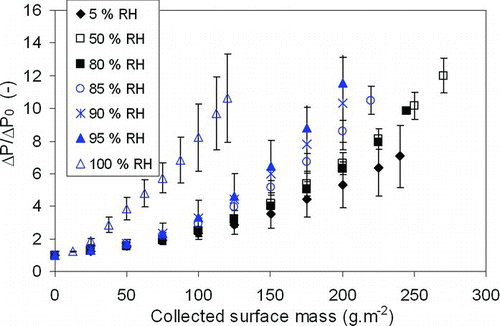
A visual observation () of the upstream face of two filters, clogged by the same mass of aerosol but deposited at two extreme humidities (RH = 5% and RH = 95%), shows that more pleats remain open for the filter clogged in dry air and this explains why its pressure drop is lower. Thus, with the micron-sized aluminium oxide particles, the influence of humidity is more significant with flat filters than with pleated filters because the presence of humidity, almost ineffective during the cake filtration, accelerates significantly the closure of pleats.
FIG. 12 Photographs of two pleated filters clogged by around 200 g · m−2 aluminium oxide particles at a filtration velocity of 2.6 cm · s−1: on the left at 5% RH and on the right at 95% RH.
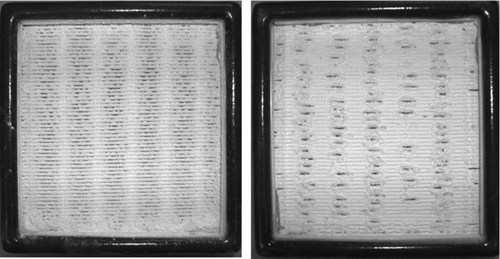
4.2.2.2. Sodium Chloride Aerosol. shows the clogging curves obtained with the hygroscopic sodium chloride aerosol at filtration velocity 2.7 cm · s−1 and various values of relative humidity between 5 and 81%. The results highlight three characteristic regions of influence dependent on the relative humidity:
-
for RH < 52%, the influence of humidity appears, as for flat filters, during the surface filtration stage: for a given collected surface mass, increase in relative humidity leads to a decrease in pressure drop. Then, during the filtration surface reduction stage, it seems that the presence of humidity accelerates the closure of pleats and so accelerates the increase in pressure drop. However, since the clogging has not been studied at pressure drop ratios greater than 16, to avoid degradation of the mechanical folds, this stage is only beginning;
-
for RH ≈ 60–70%, the increase in pressure drop is larger and seems to be located in a transition zone. Indeed, according to CitationFoster and Ewing (1999), in this range of relative humidity a thin liquid film is adsorbed on the surface of sodium chloride particles which may explain the atypical evolution of clogging of the filters. Observation of the upstream face of the filters after clogging, reveals that many pleats are glued to each other, which explains the large increase in pressure drop;
-
for RH > 75% (i.e., above the deliquescent point of the sodium chloride particles), the aerosol is liquid and changes in pressure drop are characteristic of liquid filtration with the formation of a liquid film on the surface of the medium corresponding to a high increase in pressure drop for a given collected surface mass.
4.2.3. Summary
The results obtained with the pleated filters have demonstrated that the influence of humidity on changes in pressure drop depends on which clogging stage is being considered:
-
at the beginning of the clogging, changes in pressure drop are similar to those for flat filters, i.e., the presence of humidity decreases the specific cake resistance; the interpretation of phenomena proposed with flat filters can be applied. The micron-sized non-hygroscopic aerosol used did not reveal much influence from humidity during this stage. Indeed, results with flat filters indicated a decrease in specific cake resistance for humidity close to saturation. However, when humidity is close to saturation reduction of the filtration area appears at very low values of collected aerosol mass;
-
when the reduction in filtration surface area becomes significant, the presence of humidity accelerates the pleat closing process, i.e., it appears at a lower value of collected surface mass. The adhesion forces between the particles, especially the capillary forces coming from capillary condensation of the water vapor into the capillaries of the particles or the formed cake, are accentuated with increasing RH and, in particular, when the aerosol is hygroscopic. Thus, one explanation would be that the greater the capillary forces, the less likely it is that the aerosol will penetrate far into the pleat. Particles accumulate at the tips of the pleats which causes the pleats to close. Therefore, the greater the humidity the faster the pleats close, leading to a greater pressure drop across the filter.
4.3. Influence of Humidity on Changes in the Efficiency of Pleated Filters
The efficiency of clogged filters has been evaluated, as for the clean filters, with a normalized soda fluorescein aerosol at the MPPS. The measurements were performed at the nominal filtration velocity (around 2.6 cm·s−1), at different degrees of clogging, i.e., for different collected surface masses of aluminium oxide or sodium chloride particles, and at various values of relative humidity.
The results are reported using the experimental change in pressure drop ![]() of a pleated filter, clogged at nominal filtration velocity, and experimental change in efficiency of pleated filters clogged under the same conditions (HR, V
f
); efficiency is expressed as the ratio
of a pleated filter, clogged at nominal filtration velocity, and experimental change in efficiency of pleated filters clogged under the same conditions (HR, V
f
); efficiency is expressed as the ratio ![]() between the decontamination factor of a clogged filter measured at the same humidity as the experimental change in pressure drop, and the initial decontamination factor measured in dry air (5% RH) when the same filter was clean.
between the decontamination factor of a clogged filter measured at the same humidity as the experimental change in pressure drop, and the initial decontamination factor measured in dry air (5% RH) when the same filter was clean.
4.3.1. Aluminium Oxide Aerosol
Changes in decontamination factor of pleated filters clogged by aluminium oxide particles and measured at 5, 95, and 100% RH are shown on . The results indicate that, whatever the relative humidity during the clogging, the ratio of decontamination factors passes through a maximum which depends on the collected surface mass.
FIG. 14 Changes in pressure drop and efficiency of pleated filters during their clogging by aluminium oxide particles at 5, 95, and 100% RH.

Initially, the ratio of decontamination factors increases during the formation of the particulate cake; in effect, the particles forming the cake become additional collectors, contributing as well as the fibers to the collection of soda fluorescein particles. The ratio of decontamination factors reaches a maximum value of 10 at 5% relative humidity and a maximum value of 3 for a clogging at 95% relative humidity (the few experimental values obtained at 100% relative humidity are inconclusive). Thus, the cake formed at 5% RH achieves a collection efficiency of soda fluorescein particles which is greater than at 95% RH. This can probably be explained to a greater degree by the characteristics of the particle deposit (greater thickness), than by the hygroscopic nature of soda fluorescein.
When the clogging is large, i.e., at pressure drop ratios greater than between 8 and 10, the results indicate that whatever the relative humidity, the ratio of decontamination factors decreases. This decrease appears for a lower collected surface mass when the change in pressure drop of the filter is fast, which occurs when the humidity is high. It can be attributed to the reduction in filtration surface leading to an increase in interstitial filtration velocity. Indeed, according to their submicronic diameter, the two main mechanisms responsible for the collection of the soda fluorescein particles are the Brownian diffusion and the interception. The particle collection by interception is a purely geometrical phenomenon. The particles, which follow trajectories such as they flow nearby the fiber, will be intercepted and collected by the fiber. The particle collection by interception is governed by the interception number R which is the ratio between the particle diameter with the fiber diameter. So, the elementary particle collection efficiency by interception is independent of the filtration velocity (CitationFriedlander 1957). The particle collection by diffusion is due to Brownian motion of the particles which have a probability to reach a fiber and to stick at the surface. The elementary particle collection efficiency by diffusion is a function of the Peclet number which depends on the filtration velocity. CitationStechkina and Fuchs (1966) have shown that if the filtration velocity increases, the elementary collection efficiency is decreasing. Thus, the overall collection efficiency of the filter, which depends on the collection efficiency of the two mechanisms by interception and diffusion, decreases if the filtration velocity is increasing.
Photographs of pleated filters after the clogging revealed the presence of preferential passages when the clogging of filters is very advanced and most pleats are totally closed. The filtration velocity in these preferential passages is very large, which decreases the collection efficiency of 0.18 μm MMAD soda fluorescein particles. Nevertheless, the values of the decontamination factor are always greater than 2000 whatever the operating conditions. 2000 is the value of decontamination factor (i.e., penetration equal to 5.10−4) usually used by the French nuclear industry as minimum efficiency value for all the filters implemented in the ventilation systems.
4.3.2. Sodium Chloride Aerosol
Changes in decontamination factor of pleated filters clogged by sodium chloride particles and measured at 5, 60, and 80% RH are shown in .
FIG. 15 Changes in pressure drop and efficiency of pleated filters during their clogging by sodium chloride particles at 5, 60, and 80% RH.
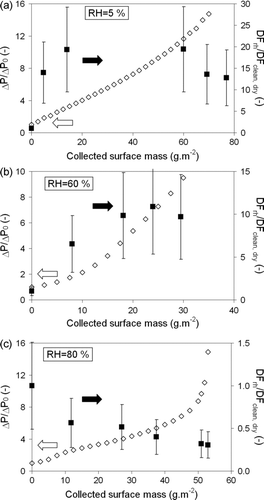
The results indicate that for the clogging performed at 5 and 60% relative humidity, hence below the deliquescent point of sodium chloride particles, the ratio of decontamination factors, as with aluminium oxide particles, reaches a maximum as a function of collected surface mass. The increase ratio of decontamination factors reaches a value of 20 at 5% relative humidity and only 10 at 60% relative humidity. Thus, the particulate cake formed at 5% relative humidity, which has a specific resistance lower than that of the cake formed at 60% relative humidity, is more efficient for the collection of soda fluorescein particles.
It seems that the decrease in the ratio of decontamination factors is less significant than with micron-sized aluminium oxide particles. Indeed, during the clogging in dry air with submicron sodium chloride particles, for a similar ![]() ratio, the reduction in filtration area is smaller than with aluminium oxide particles (the shape of the curve remains almost linear); this means that at the end of the clogging, the filtration velocity in the filter clogged by sodium chloride particles is lower and therefore the ratio of decontamination is larger.
ratio, the reduction in filtration area is smaller than with aluminium oxide particles (the shape of the curve remains almost linear); this means that at the end of the clogging, the filtration velocity in the filter clogged by sodium chloride particles is lower and therefore the ratio of decontamination is larger.
For clogging performed at 80% relative humidity, the sodium chloride particles are in liquid form. The results indicate that the ratio of efficiency decreases during the clogging. According to CitationPayet et al. (1992), the droplets of sodium chloride are deposited on the surface of the fibers leading to formation of liquid bridges; thus, the amount of fibers available for the collection of soda fluorescein particles decreases and therefore the collection efficiency of the filter is reduced.
Whatever the operating conditions, the values of the decontamination factor are always greater than 2000.
5. CONCLUSIONS
This study dealt with the influence of humidity during the clogging of HEPA filters by hygroscopic and non-hygroscopic aerosols. Clogging tests were carried out with flat and mini-pleated HEPA filters to determine the influence of the geometry of the filter. The experimental tests have been realized in order to respond to safety concerns encountered in the nuclear industry. The results obtained with the pleated filters constitute a relevant data base which could be useful in incidental conditions involving a release of humidity.
Results confirmed the influence of the hygroscopicity of the aerosol on changes in the pressure drop of flat filters; the same observations have been obtained with pleated filters. For the pleated filters, the results highlighted that the influence of relative humidity depends on the stage of clogging. The phenomena, observed during the formation of the particulate cake and the closure of the pleats, are related, in both cases, to changes in the bonding forces between particles with relative humidity. Thus, conclusions made for flat filters cannot be entirely applied to pleated filters. The study has also investigated the influence of humidity on the efficiency, measured around the most penetrating particle size with normalized hygroscopic soda fluorescein particles, of clean and clogged pleated HEPA filters.
This work provides the experimental basis needed to develop an empirical model to predict the clogging of HEPA filters in the presence of relative humidity. The model should take into account the hygroscopicity of the aerosol, the air humidity and the geometry of the filter.
This work has been supported by the Institute for Radiological Protection and Nuclear Safety in France (IRSN) and AREVA NC in collaboration with the Laboratory of Reactions and Chemical Engineering of Nancy University.
References
- Biskos , G. , Malinowski , A. , Russell , L. M. , Buseck , P. R. and Martin , S. T. 2006 . Nanosize Effect on the Deliquescence and Efflorescence of Sodium Chloride Particles. . Aerosol Sci. Technol. , 40 : 97 – 106 .
- Butt , H. J. and Kappl , M. 2009 . Normal Capillary Forces. . Adv. Colloid Interfac. , 146 : 48 – 60 .
- Contal , P. , Simao , J. , Thomas , D. , Frising , T. , Callé , S. , Appert-Collin , J. C. and Bémer , D. 2004 . Clogging of Fibre by Submicron Droplets. Phenomena and Influence of Operating Conditions. . Aerosol Sci. , 35 : 263 – 278 .
- Del Fabbro , L. , Laborde , J. C. , Lacan , J. , Merlin , P. and Ricciardi , L. 2001 . “ Influence of Geometric and Aeraulic Parameters on the Clogging of Industrial Pleated Filters by Solid Particles ” . In Proc. Filtech Conference, Dusseldorf.
- Ebert , M. , Inerle-Hof , M. and Weinbruch , S. 2002 . Environmental Scanning Electron Microscopy as a New Technique to Determine the Hygroscopic Behaviour of Individual Aerosol Particles. . Atmos. Environ. , 36 : 5909 – 5916 .
- Feng , C. L. and Yu , A. B. 1998 . Effect of Liquid Addition on the Packing of Mono-Sized Coarse Spheres. . Powder Technol. , 99 : 22 – 28 .
- Foster , M. and Ewing , G. E. 1999 . An Infrared Spectroscopic Study of Water Thin Film on NaCl (100). . Surf. Sci. , 427–428 : 102 – 106 .
- Friedlander , S. K. 1957 . Mass and Heat Transfer to Single Spheres and Cylinders at Low Reynolds Numbers. . AIChE J. , 3 : 43 – 48 .
- Gregory , W. S. , Martin , R. A. , Smith , P. R. and Fenton , D. E. 1982 . “ Response of HEPA Filters to Simulated Accident Conditions ” . In Proc. 17th DOE Nuclear Air Cleaning Conference.
- Gupta , A. , Novick , V. J. , Biswas , P. and Monson , P. R. 1993 . Effect of Humidity and Particle Hygroscopicity on the Mass Loading Capacity of High Efficiency Particulate Air (HEPA) Filter. . Aerosol Sci. Tech. , 19 : 94 – 107 .
- Krämer , L. , Pöschl , U. and Niessner , R. 2000 . Microstructural Rearrangement of Sodium Chloride Condensation Aerosol Particles on Interaction with Water Vapor. . J. Aerosol Sci. , 6 : 673 – 685 .
- Miguel , A. F. 2003 . Effect of Air Humidity on the Evolution of Permeability and Performance of a Fibrous Filter During Loading with Hygroscopic and Non-Hygroscopic Particles. . J. Aerosol Sci. , 34 : 783 – 99 .
- Mikhailov , E. F. , Vlasenko , S. S. , Krämer , L. and Niessner , R. 2001 . Interaction of Soot Aerosol Particles with Water Droplets: Influence of Surface Hydrophilicity. . J. Aerosol Sci. , 32 : 697 – 711 .
- Normann , B. 1987 . “ The Effects of High Relative Humidities on HEPA Filter Media ” . In Proc. 19th DOE/NRC Nuclear Air Cleaning Conference.
- Novick , V. J. , Monson , P. R. and Ellison , P. E. 1992 . The Effect of Solid Particle Mass Loading on the Pressure Drop of HEPA Filters. . J. Aerosol Sci. , 23 ( 6 ) : 657 – 665 .
- Payet , S. , Boulaud , D. , Madeleine , G. and Renoux , A. 1992 . Penetration and Pressure Drop of a HEPA Filter During Loading with Submicron Liquid Particles. . J. Aerosol Sci. , 23 ( 7 ) : 723 – 735 .
- Pénicot , P. , Thomas , D. , Contal , P. , Leclerc , D. and Vendel , J. 1999 . Clogging of HEPA Fibrous Filters by Solid and Liquid Aerosol Particles: An Experimental Study. . Filtr. Separat. , 36 ( 2 ) : 59 – 64 .
- Rebai , M. , Prat , M. , Meireles , M. , Schmitz , P. and Baclet , R. 2009 . “ Clogging Modelling in Pleated Filters for Gas Filtration ” . In Chem. Engineer. Res. Design doi: 10.1016/j.cherd.2009.08.014.
- Smith , P. R. , Leslie , I. H. , Hensel , E. C. , Schultheis , T. M. and Walls , J. R. 1993 . “ Structural Testing of Salt Loaded HEPA Filters WIPP ” . In Proc. 22nd DOE/NRC Nuclear Air Cleaning and Treatment Conference.
- Stechkina , I. B. and Fuchs , N. A. 1966 . Studies on Fibrous Aerosol Filters. Calculation of Diffusional Deposition of Aerosols in Fibrous Filters. . Ann. Occup. Hyg. , 9 : 59 – 64 .
- Thomas , D. , Penicot , P. , Contal , P. , Leclerc , D. and Vendel , J. 2001 . Clogging of Fibrous Filters by Solid Aerosol Particles. Experimental and Modelling Study. . Chem. Eng. Sci. , 56 ( 11 ) : 3549 – 3561 .
- Walsh , D. C. 1996 . Recent Advances in the Understanding of Fibrous Filter Behaviour Under Solid Particle Load. . Filtr. Separat. , 3 : 501 – 505 .
- Weingartner , E. , Baltensperger , U. and Burtscher , H. 1995 . Growth and Structural Changes of Combustion Aerosols at High Relative Humidity. . J. Aerosol Sci. , 26 : 667 – 668 .
